Uzbekistan, Kyrgyzstan & Kazakhstan Tour
17 Days Private Tour of Tashkent - Khiva - Bukhara - Samarkand - Tashkent - Kokand - Fergana - Andijan - Osh - Bishkek - Cholpon Ata - Karakol - Saty - Basshi - Almaty
Tour Type: Private guided tour, flexible and customizable
Guide: Private driver and guide in Uzbekistan and Kyrgyzstan; private driver guide in Kazakhstan
Transportation: Air-conditioned private car, spacious and comfortable
Hotels: 3 to 5-star handpicked hotels & guest houses, open to your choice
Meals: 16 breakfasts, 8 lunches, 8 dinners
Code: TCA105
Guide: Private driver and guide in Uzbekistan and Kyrgyzstan; private driver guide in Kazakhstan
Transportation: Air-conditioned private car, spacious and comfortable
Hotels: 3 to 5-star handpicked hotels & guest houses, open to your choice
Meals: 16 breakfasts, 8 lunches, 8 dinners
Code: TCA105
This trip can be customized to meet your individual needs!
Free InquiryGet our reply within 24 hours!
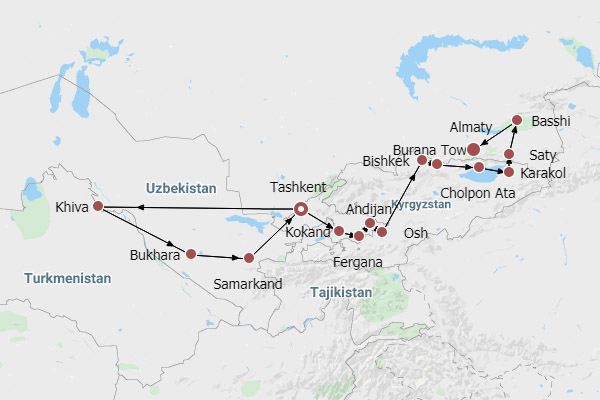
- Overview
- Itinerary
- Reviews
Tour Overview
If you are deeply into the mysterious Central Asian culture and plan a long journey touring iconic cities on the ancient Silk Road, our Uzbekistan Kyrgyzstan Kazakhstan tour packages will suffice your needs. Starting with Uzbekistan, you will admire the combination of modern architecture and historical madrasahs in Tashkent, roam in the endearing ancient city of Khiva, visit ubiquitous religious sites in Bukhara and Samarkand, and also explore Kokand, Fergana, Margilan, and Andijan. When you move on to Kyrgyzstan, stroll in landmark squares in Bishkek and appreciate petroglyphs in Osh and Cholpon Ata, all of which will let you feel the influence of nomadic culture. Finally, reach Kazakhstan to enjoy various eye-popping landscapes of Altyn Emel National Park, marvelous Charyn Canyon, and picturesque alpine Kolsai Lakes. Whether you want to adjust travel days or destinations, we can tailor a personalized tour for you! ... Read more
Trip Highlights
- Appreciate both traditional religious complexes and artfully designed modern metro stations in Tashkent.
- Meander in UNESCO World Heritage Itchan Kala in the enigmatic ancient city, Khiva.
- Witness the Kalyan Minaret in Bukhara that even impressed Genghis Khan.
- Hike in Ala Archa National Park in Bishkek to gasp at the otherworldly picturesque scenery.
- Admire the jaw-dropping rocky landscapes of Charyn Canyon & Altyn Emel National Park in Almaty.
Expand All
Collapse All
Day 1 Tashkent Airport Pick-up & City Tour
Welcome to Uzbekistan! After meeting your private driver and guide at Tashkent Airport, they will transfer you to check in the hotel and show you around Tashkent, the capital and largest city of Uzbekistan.
Start with the Hazrati Imam Complex, one of Tashkent’s most magnificent religious complexes and Uzbekistan’s religious center. The sparkling minarets and majestic architecture of Barakhan Madrasah, Tillya Sheikh Mosque, Mausoleum of Saint Abu Bakr Kaffal Shashi, and Imam Al Bukhari Islamic Institute will fill you with sacred Islamic culture. Then, head to Chorsu Bazaar, Tashkent’s most famous farmers’ market, shrouded in a vast green dome, with sunlight pouring in through the skylight. Here, you can see a large number of spices piled up into small hills, sacks of grain as big as cars, small sheds filled with dairy products, and endless zones hanging freshly slaughtered livestock, as well as seasonal fruits like pomegranates, melons, persimmons, and huge tomatoes, all of which let you fully feel the residents’ life.
Next, experience the metro ride and appreciate the metro stations made with marble and granite, decorated with ethnic aesthetics under the light and shadow of crystal chandeliers. After exiting, move to Mustakillik Square, whose magnificent gate comprises 16 unforgettable white marble columns. Passing through the silver arch with the image of Semurg (Bird of Happiness) around the fountain, you will see the central monument – a golden globe stands on a high pedestal, and opposite it stands the statue of “Crying Mother,” symbolizing the independence and rebirth of Uzbekistan.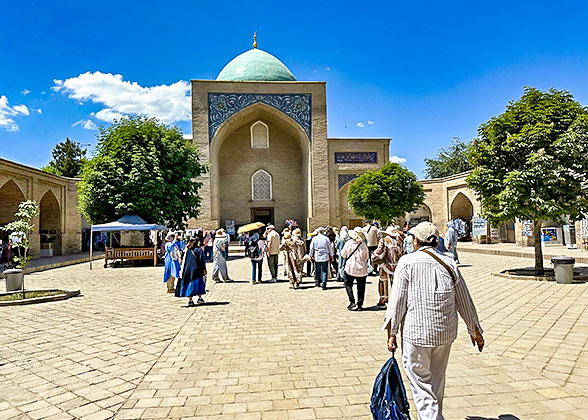
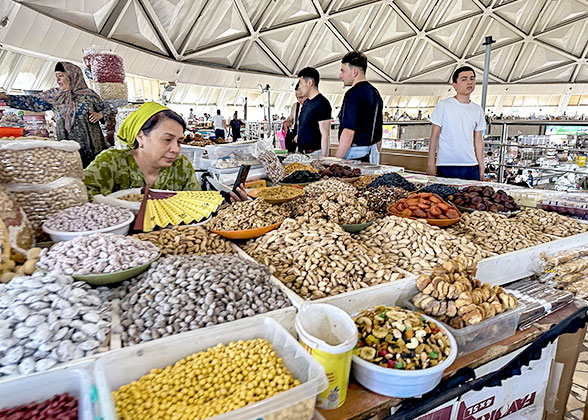 Continue to visit Amir Temur Square, where a statue of Timur looks mighty as he rides a horse and holds a sword in his hand. One of the most famous conquerors in the history of Central Asia, Timur’s (1336-1405) outstanding achievements often misled that he is a descendant of Genghis Khan. After all, Timur established a vast empire from the Indus River in the east to the Euphrates River in the west, from the Caucasus in the north to the Persian Gulf in the south in 40 years. He even wanted to continue his expedition to China to restore the glory of Genghis Khan’s time but failed to do so due to a fatal illness, making it difficult for people not to compare him with Genghis Khan.
Continue to visit Amir Temur Square, where a statue of Timur looks mighty as he rides a horse and holds a sword in his hand. One of the most famous conquerors in the history of Central Asia, Timur’s (1336-1405) outstanding achievements often misled that he is a descendant of Genghis Khan. After all, Timur established a vast empire from the Indus River in the east to the Euphrates River in the west, from the Caucasus in the north to the Persian Gulf in the south in 40 years. He even wanted to continue his expedition to China to restore the glory of Genghis Khan’s time but failed to do so due to a fatal illness, making it difficult for people not to compare him with Genghis Khan.
Today’s last stop is the Museum of Applied Art, hailed as an example of late 19th-century Uzbek oriental architecture and decorative art, showcasing the sculptures and paintings of folk artists from all over Uzbekistan. Finally, the guide will escort you back to your hotel.
Accommodation: Ateca Hotel Suites Tashkent (4 stars) or similar
Start with the Hazrati Imam Complex, one of Tashkent’s most magnificent religious complexes and Uzbekistan’s religious center. The sparkling minarets and majestic architecture of Barakhan Madrasah, Tillya Sheikh Mosque, Mausoleum of Saint Abu Bakr Kaffal Shashi, and Imam Al Bukhari Islamic Institute will fill you with sacred Islamic culture. Then, head to Chorsu Bazaar, Tashkent’s most famous farmers’ market, shrouded in a vast green dome, with sunlight pouring in through the skylight. Here, you can see a large number of spices piled up into small hills, sacks of grain as big as cars, small sheds filled with dairy products, and endless zones hanging freshly slaughtered livestock, as well as seasonal fruits like pomegranates, melons, persimmons, and huge tomatoes, all of which let you fully feel the residents’ life.
Next, experience the metro ride and appreciate the metro stations made with marble and granite, decorated with ethnic aesthetics under the light and shadow of crystal chandeliers. After exiting, move to Mustakillik Square, whose magnificent gate comprises 16 unforgettable white marble columns. Passing through the silver arch with the image of Semurg (Bird of Happiness) around the fountain, you will see the central monument – a golden globe stands on a high pedestal, and opposite it stands the statue of “Crying Mother,” symbolizing the independence and rebirth of Uzbekistan.

Hazrati Imam Complex

Chorsu Bazaar
Today’s last stop is the Museum of Applied Art, hailed as an example of late 19th-century Uzbek oriental architecture and decorative art, showcasing the sculptures and paintings of folk artists from all over Uzbekistan. Finally, the guide will escort you back to your hotel.
Accommodation: Ateca Hotel Suites Tashkent (4 stars) or similar
Day 2 Tashkent to Khiva by Air: Visit Iconic Madrasahs, Minarets, Mosques & Mausoleum of Itchan Kala
This morning, the guide and driver will escort you to the airport for a 1.5-hour flight to Khiva. After landing, the local driver will pick you up and escort you to the hotel. On the ancient Silk Road, a proverb goes, “I’d give a bag of gold to see Khiva,” which indicates that Khiva is fantastic and challenging to reach. However, thanks to modern transportation, driving from the airport to meet the endearing Khiva only takes half an hour.
After hotel check-in, follow the local guide to tour Itchan Kala, once the living place for Khiva imperials and listed as a World Heritage Site in 1990. Royal palaces and mausoleums with blue domes and mud walls seem frozen in time, and 122 preserved historical buildings built from the 5th to the 20th century show the exquisite skills of architects from the Khwarazm regions.
In the center of Itchan Kala are Muhammad Amin Khan Madrasah and Mohammed Rakhim Khan Madrassah, pretty and majestic for photography. Nearby is the Kalta Minor Minaret, a round, turquoise-tiled minaret built in 1851, designed for Mohammed Amin Khan to see Bukhara from afar. Unfortunately, Amin Khan died accidentally in 1855, and the minaret became unfinished.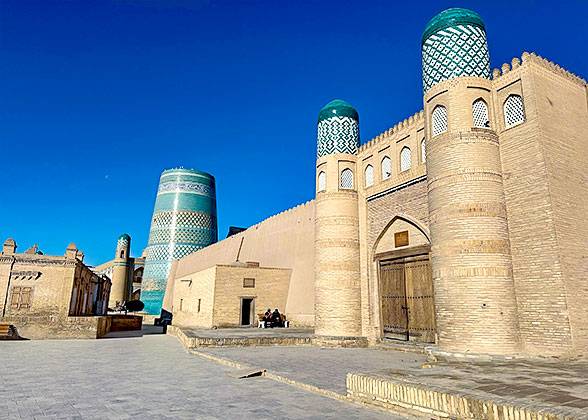
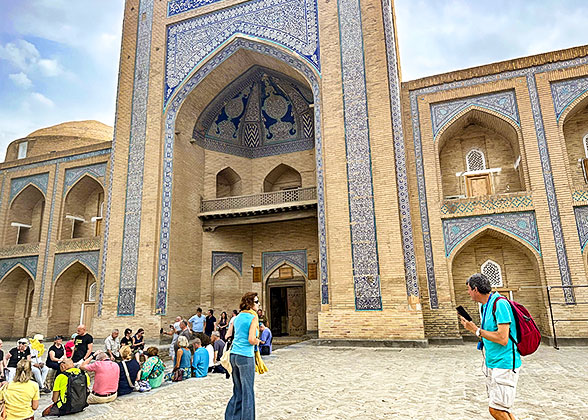 Then, come to Juma Mosque, a rare all-wooden building supported by 218 pillars, each with unique carvings, some of which are said to date back to the 10th century. Looking closely, you will see that no two pillars are the same size, shape or pattern. At noon, when the sun shines into the mosque through two square skylights, the Tyndall effect creates an incredible feeling of alternation between day and night.
Then, come to Juma Mosque, a rare all-wooden building supported by 218 pillars, each with unique carvings, some of which are said to date back to the 10th century. Looking closely, you will see that no two pillars are the same size, shape or pattern. At noon, when the sun shines into the mosque through two square skylights, the Tyndall effect creates an incredible feeling of alternation between day and night.
Our next stop is Toshkhovli Palace, which has the most luxurious interior decoration in Khiva, including tile stone carvings, wood carvings and plaster decorations. Stroll to admire its blue-painted-tiles-covered walls, even the intricately carved base of Islamic wooden columns, and well-painted ceiling. Keep moving to the Pahlavan Mahmoud Mausoleum. As a highly respected poet, philosopher and legendary wrestler, Pahlavan had his mausoleum built by many renowned masters, from the tombstone to the civil engineering to the decoration, making the mausoleum a majestic building with the largest dome in Khiva, covered with glittering gilded blue glazed tiles, which defined the Khiva architectural style in the following decades.
Afterward, we will reach Islam Khoja Minaret, the most recent Islamic site in Khiva built in 1910. The pine green and red tiles make it look like a rather lovely lighthouse, and its height of 57 meters makes it the tallest building in Khiva, which you can climb up to overlook the whole city. Before dusk, we will arrive at the last destination, Kunya-Ark, which used to be the ruler’s castle and residence. From its viewing platform, let’s enjoy a panoramic view of Khiva in the setting sun.
Meal: Breakfast
Accommodation: Hotel Asia Khiva (3 stars) or similar
After hotel check-in, follow the local guide to tour Itchan Kala, once the living place for Khiva imperials and listed as a World Heritage Site in 1990. Royal palaces and mausoleums with blue domes and mud walls seem frozen in time, and 122 preserved historical buildings built from the 5th to the 20th century show the exquisite skills of architects from the Khwarazm regions.
In the center of Itchan Kala are Muhammad Amin Khan Madrasah and Mohammed Rakhim Khan Madrassah, pretty and majestic for photography. Nearby is the Kalta Minor Minaret, a round, turquoise-tiled minaret built in 1851, designed for Mohammed Amin Khan to see Bukhara from afar. Unfortunately, Amin Khan died accidentally in 1855, and the minaret became unfinished.

Kalta Minor, Khiva

Madrasa Mohammed Amin Khan, Khiva
Our next stop is Toshkhovli Palace, which has the most luxurious interior decoration in Khiva, including tile stone carvings, wood carvings and plaster decorations. Stroll to admire its blue-painted-tiles-covered walls, even the intricately carved base of Islamic wooden columns, and well-painted ceiling. Keep moving to the Pahlavan Mahmoud Mausoleum. As a highly respected poet, philosopher and legendary wrestler, Pahlavan had his mausoleum built by many renowned masters, from the tombstone to the civil engineering to the decoration, making the mausoleum a majestic building with the largest dome in Khiva, covered with glittering gilded blue glazed tiles, which defined the Khiva architectural style in the following decades.
Afterward, we will reach Islam Khoja Minaret, the most recent Islamic site in Khiva built in 1910. The pine green and red tiles make it look like a rather lovely lighthouse, and its height of 57 meters makes it the tallest building in Khiva, which you can climb up to overlook the whole city. Before dusk, we will arrive at the last destination, Kunya-Ark, which used to be the ruler’s castle and residence. From its viewing platform, let’s enjoy a panoramic view of Khiva in the setting sun.
Meal: Breakfast
Accommodation: Hotel Asia Khiva (3 stars) or similar
Day 3 Khiva – Kyzylkum Desert – Bukhara
After breakfast, we’ll drive one hour to stop at Kyzylkum Desert to admire the desert scenery and the Amu Darya River. Then, continue driving for 6.5 hours to Bukhara, the most sacred city in Central Asia. You can relax in the hotel for the remaining time to relieve the fatigue of the long-distance car ride.
In the maze-like alleys in Bukhara’s old city center, many buildings have maintained their original appearance for two centuries. Most of the city is architectural protection areas, with Islamic schools and minarets everywhere. Compared with the splendor of Samarkand, Bukhara has a more undecorated sense of vicissitudes, whose single earthy yellow hue is a reflection of the decline of Central Asian civilization.
► Recommended Dish in Bukhara (at your own expense)
Pilaf, a rice dish, is Uzbek’s favorite national food, always served at festivals, weddings and birthday parties. Therefore, The ART Plov restaurant, a 10-minute taxi ride from your hotel, is unmissable, where you can taste authentic local pilaf. The restaurant provides two styles of pilaf, Samarkand and Bukhara, with the difference in the rice. It is recommended to order the Bukhara pilaf, whose rice and meat are sufficient and prosperous with fragrance. Also, a refreshing salad can help balance the greasiness.
Average Cost per Person: UZS 50,000-100,000 (about $4-8)
Address: QCMG+MCH, Bukhara, Bukhara Region
Meal: Breakfast
Accommodation: Amulet Hotel, Bukhara (3 stars) or similar
In the maze-like alleys in Bukhara’s old city center, many buildings have maintained their original appearance for two centuries. Most of the city is architectural protection areas, with Islamic schools and minarets everywhere. Compared with the splendor of Samarkand, Bukhara has a more undecorated sense of vicissitudes, whose single earthy yellow hue is a reflection of the decline of Central Asian civilization.
► Recommended Dish in Bukhara (at your own expense)
Pilaf, a rice dish, is Uzbek’s favorite national food, always served at festivals, weddings and birthday parties. Therefore, The ART Plov restaurant, a 10-minute taxi ride from your hotel, is unmissable, where you can taste authentic local pilaf. The restaurant provides two styles of pilaf, Samarkand and Bukhara, with the difference in the rice. It is recommended to order the Bukhara pilaf, whose rice and meat are sufficient and prosperous with fragrance. Also, a refreshing salad can help balance the greasiness.
Average Cost per Person: UZS 50,000-100,000 (about $4-8)
Address: QCMG+MCH, Bukhara, Bukhara Region
Meal: Breakfast
Accommodation: Amulet Hotel, Bukhara (3 stars) or similar
Day 4 Bukhara: Lyabi Khause Ensemble, Poyi Kalon Complex, Iconic Madrasahs, Mosques & Mausoleums
Today, you will spend a whole day exploring Bukhara with your guide. Start with the Lyabi Khause ensemble, a square built in 1620 around a stone pond, shaded by old mulberry trees. You’ll encounter many residents turning themselves loose at this peaceful and enjoyable place. Then, walk to Magoki Attori Mosque, built in the 9th century, one of the oldest mosques in Bukhara. Once a religious temple, it is now become a carpet museum.
Continue meandering in labyrinthine alleys, and we’ll come across Chor Minor Madrasah, which means “four minarets” in Tajik and shows up in a distinctly Indian style. The next stop is Trading Domes, the local trading center, built in the 16th century based on three domed buildings: Toki-Sarrofon for money changers, Toki-Telpak Furushon for headdress sellers, and Toki-Zargaron for jewelers. Currently, most shops on Hakikat Road - the promenade that connects these domed markets - sell handicrafts, ideal for buying featured souvenirs.
After visiting Ulugʻbek Madrasasi and Abdulaziz Khan Madrassah, move forward to appreciate the Poyi Kalon complex, including Kalyan Minaret, Kalyan Mosque and Miri-Arab Madrasah. The most famous of them, the Kalyan Minaret, was built in 1127 and was probably the tallest building in Central Asia then. Kalyan means “great” in Tajik, worthy of the name that it was admired by the most potent conqueror, Genghis Khan. The legend goes that Genghis Khan’s hat fell to the ground when he looked up at the top of the 155-foot-high minaret; as he stooped to pick up the hat, he was surprised to find that this was the only place in Central Asia that made him bow down, so he ordered not to destroy Kalyan Minaret, which survived to be preserved to this day.
Then, follow your guide to the spectacular Ark Fortress, the oldest building in Bukhara, once a royal palace and now a historical museum. Although about 80% of the buildings were reduced to ruins in the 1920 bombing, with only a few royal residences remaining, you can see the 17th-century Juma Mosque at the top of the entrance ramp, as well as the second building on the left, the oldest existing part of Ark Fortress, which further reminds us to pay attention to the protection of ancient structures. Keep going to Bolo Hauz Mosque, which means the mosque on the pond, because a reservoir in front of the mosque can reflect its image. In addition, its unique feature is the 20 substantial wooden carved pillars at the entrance, especially when wood is more valuable than stone bricks in Uzbekistan. Although the erosion of time has worn away many exquisite carvings, you can still feel the uncanny craft.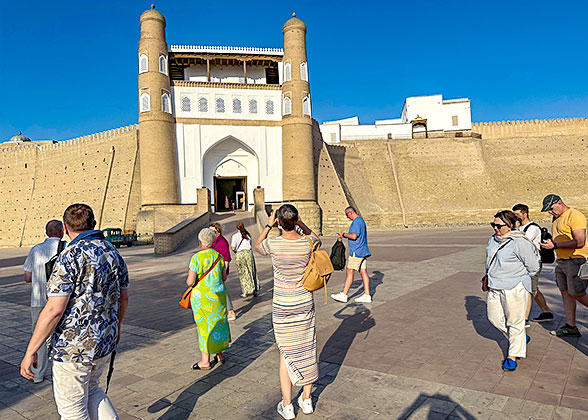
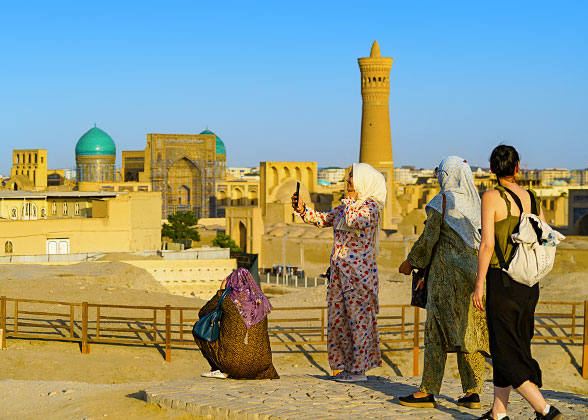 Finally, we will visit two mausoleums. The oldest Islamic building in Central Asia, the Samanid Mausoleum, was built for a Samanid monarch in the late 9th century and is the only building that survived from that era. Admire this UNESCO World Heritage Site with outstanding Islamic architecture, including mini domes, pointed arches, delicate entrances, and complex geometric patterns of columns. And hear about a gripping story at Chashmai Ayub Mausoleum. Before Bukhara came into being, Chashmai Ayub encountered a terrible drought here. When he saw people dying of thirst, he struck the dusty earth, and suddenly, a limpid, sweet, cool spring gushed out. Now, it’s said that his mausoleum marks where the spring appeared.
Finally, we will visit two mausoleums. The oldest Islamic building in Central Asia, the Samanid Mausoleum, was built for a Samanid monarch in the late 9th century and is the only building that survived from that era. Admire this UNESCO World Heritage Site with outstanding Islamic architecture, including mini domes, pointed arches, delicate entrances, and complex geometric patterns of columns. And hear about a gripping story at Chashmai Ayub Mausoleum. Before Bukhara came into being, Chashmai Ayub encountered a terrible drought here. When he saw people dying of thirst, he struck the dusty earth, and suddenly, a limpid, sweet, cool spring gushed out. Now, it’s said that his mausoleum marks where the spring appeared.
Meal: Breakfast
Accommodation: Amulet Hotel, Bukhara (3 stars) or similar
Continue meandering in labyrinthine alleys, and we’ll come across Chor Minor Madrasah, which means “four minarets” in Tajik and shows up in a distinctly Indian style. The next stop is Trading Domes, the local trading center, built in the 16th century based on three domed buildings: Toki-Sarrofon for money changers, Toki-Telpak Furushon for headdress sellers, and Toki-Zargaron for jewelers. Currently, most shops on Hakikat Road - the promenade that connects these domed markets - sell handicrafts, ideal for buying featured souvenirs.
After visiting Ulugʻbek Madrasasi and Abdulaziz Khan Madrassah, move forward to appreciate the Poyi Kalon complex, including Kalyan Minaret, Kalyan Mosque and Miri-Arab Madrasah. The most famous of them, the Kalyan Minaret, was built in 1127 and was probably the tallest building in Central Asia then. Kalyan means “great” in Tajik, worthy of the name that it was admired by the most potent conqueror, Genghis Khan. The legend goes that Genghis Khan’s hat fell to the ground when he looked up at the top of the 155-foot-high minaret; as he stooped to pick up the hat, he was surprised to find that this was the only place in Central Asia that made him bow down, so he ordered not to destroy Kalyan Minaret, which survived to be preserved to this day.
Then, follow your guide to the spectacular Ark Fortress, the oldest building in Bukhara, once a royal palace and now a historical museum. Although about 80% of the buildings were reduced to ruins in the 1920 bombing, with only a few royal residences remaining, you can see the 17th-century Juma Mosque at the top of the entrance ramp, as well as the second building on the left, the oldest existing part of Ark Fortress, which further reminds us to pay attention to the protection of ancient structures. Keep going to Bolo Hauz Mosque, which means the mosque on the pond, because a reservoir in front of the mosque can reflect its image. In addition, its unique feature is the 20 substantial wooden carved pillars at the entrance, especially when wood is more valuable than stone bricks in Uzbekistan. Although the erosion of time has worn away many exquisite carvings, you can still feel the uncanny craft.

Ark Fortress, Bukhara

Kalyan Minaret, Bukhara
Meal: Breakfast
Accommodation: Amulet Hotel, Bukhara (3 stars) or similar
Day 5 Bukhara: Visit Summer Palace, Naqsband Mausoleum & Chor Bakr Complex; Drive to Samarkand
This morning, we will continue exploring Bukhara by visiting Sitorai Mokhi-Khosa (Summer Palace) first. At such a residence of the last ruler of Bukhara and the only one of its kind that has survived so far, you can see both traditional Bukhara architectural style and the combination of European and Central Asian styles, where the lavishly decorated halls, rooms, and large garden with fountains allow you to imagine the luxurious life of the royals at that time.
Next, head to Bakhautdin Naqsband Mausoleum, in the memory of the founder of the Sufi Naqshbandi, praised as the Holy Mecca in Central Asia, where believers from different Muslim countries come to pray for their wishes. Finally, we’ll arrive at the last stop in Bukhara, Chor Bakr Memorial Complex, translated as “four brothers.” Unlike other Uzbek mausoleums, the tomb complex is designed in a Khazira structure, surrounded by solid walls with only one beautifully decorated doorway.
After all visits, the driver will escort you on a 4-hour drive to Samarkand. No other city evokes the ancient Silk Road like Samarkand. For most people, it is like the legendary Atlantis, a city described only by poets and playwrights but rarely visited. Now, with its former Soviet-era buildings, parks and wide avenues coming into your eyes, modern Samarkand is gradually becoming vivid.
Meal: Breakfast
Accommodation: Hotel Grand Samarkand (4 stars) or similar
Next, head to Bakhautdin Naqsband Mausoleum, in the memory of the founder of the Sufi Naqshbandi, praised as the Holy Mecca in Central Asia, where believers from different Muslim countries come to pray for their wishes. Finally, we’ll arrive at the last stop in Bukhara, Chor Bakr Memorial Complex, translated as “four brothers.” Unlike other Uzbek mausoleums, the tomb complex is designed in a Khazira structure, surrounded by solid walls with only one beautifully decorated doorway.
After all visits, the driver will escort you on a 4-hour drive to Samarkand. No other city evokes the ancient Silk Road like Samarkand. For most people, it is like the legendary Atlantis, a city described only by poets and playwrights but rarely visited. Now, with its former Soviet-era buildings, parks and wide avenues coming into your eyes, modern Samarkand is gradually becoming vivid.
Meal: Breakfast
Accommodation: Hotel Grand Samarkand (4 stars) or similar
Day 6 Samarkand: Visit Registan Square & Bibi Khanym Mosque; High-speed Train to Tashkent
Today, you’ll be guided to explore landmarks in Samarkand, with the most iconic one as Registan Square, known as the “Heart of Samarkand.” Here, you’ll see three magnificent madrasas: Ulugh Beg Madrasa, Madrassa Sherdor and Tilya-Kori Madrasah, representing the most outstanding architecture of the Timurid Empire in the late 14th century. First built in 1409, Ulugh Beg Madrasa stands for the exceptional scientific education and is one of the best Muslim institutions of the 15th century. In 1636, Madrassa Sherdor, which means hidden lion, was completed. Twenty-four years later, Tilya-Kori Madrasah, named after its dome covered with gold leaves, trumped all the famous buildings in Central Asia, symbolizing the prosperity of Samarkand at that time. Standing in the center of the square, you will be deeply shocked by the Islamic culture.
Then, turn your eyes to the lively scene in Siyob Bozor, a necessary market for residents, bursting with dried fruits, spices, nuts, dairy products, etc. Many sellers good in English will warmly invite you to taste. If you want to buy ornaments, refrigerator magnets, local costumes or unique hats as souvenirs, your guide can help compare prices and bargain. Nearby is Bibi Khanym Mosque, named after Timur’s wife. Legend has it that Timur ordered to build of the mosque after defeating India to show the empire’s majesty and glory and commemorate his wife. Its typical Islamic features of magnificent appearance, tall and exquisite domes, and gorgeous tile patterns on the brick walls will impress you at first glance.
Afterward, we go to the Observatory of Ulugbek, whose designer was an outstanding monarch of the Timurid Empire (1370-1507) but more famous as an astronomer because he designed a 30-meter-long (98-foot) ladder observation instrument to observe the positions of stars. The next stop is the most dazzling and beautiful mausoleum complex in Samarkand, Shah-i-Zinda, which means the “immortal king,” referring to Kusam ibn Abbas, cousin of Muhammad, the founder of Islam. Along the 500-meter (545-yd) road leading to Abbas’s mausoleum, amazed by over two dozen mausoleums decorated with exquisite tiles.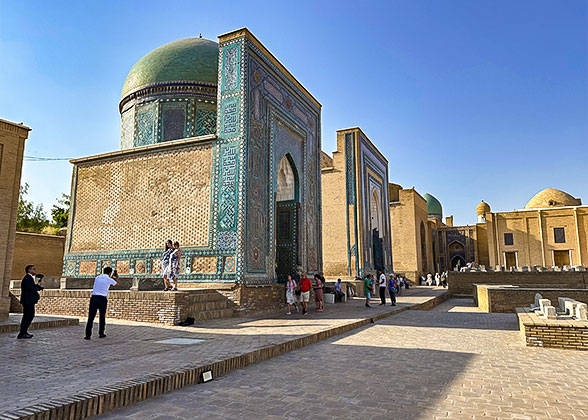
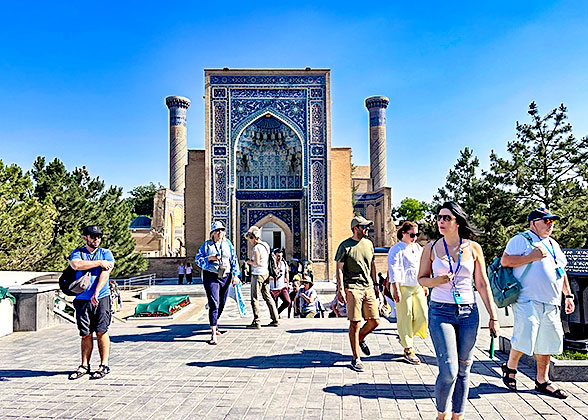 Finally, our Samarkand tour will end at Gur-e-Amir Mausoleum, the most magnificent mausoleum in Uzbekistan and the tomb complex of Amir Timur’s family. As you enter the gateway, you will be shocked by its super gorgeous dome reminiscent of a poet’s lament, “If the sky disappears, this dome can be the alternative.” Gasp at the dazzling geometric patterns of gold and indigo and fine mosaics inside, incredibly luxurious under illumination, profoundly influencing later architectural designs, such as the Taj Mahal in India.
Finally, our Samarkand tour will end at Gur-e-Amir Mausoleum, the most magnificent mausoleum in Uzbekistan and the tomb complex of Amir Timur’s family. As you enter the gateway, you will be shocked by its super gorgeous dome reminiscent of a poet’s lament, “If the sky disappears, this dome can be the alternative.” Gasp at the dazzling geometric patterns of gold and indigo and fine mosaics inside, incredibly luxurious under illumination, profoundly influencing later architectural designs, such as the Taj Mahal in India.
Farewell to Samarkand. The driver will transfer you to the railway station for a 2-hour high-speed train to Tashkent. After arriving, the local driver will pick you up and escort you to the hotel.
Meal: Breakfast
Accommodation: Ateca Hotel Suites Tashkent (4 stars) or similar
Then, turn your eyes to the lively scene in Siyob Bozor, a necessary market for residents, bursting with dried fruits, spices, nuts, dairy products, etc. Many sellers good in English will warmly invite you to taste. If you want to buy ornaments, refrigerator magnets, local costumes or unique hats as souvenirs, your guide can help compare prices and bargain. Nearby is Bibi Khanym Mosque, named after Timur’s wife. Legend has it that Timur ordered to build of the mosque after defeating India to show the empire’s majesty and glory and commemorate his wife. Its typical Islamic features of magnificent appearance, tall and exquisite domes, and gorgeous tile patterns on the brick walls will impress you at first glance.
Afterward, we go to the Observatory of Ulugbek, whose designer was an outstanding monarch of the Timurid Empire (1370-1507) but more famous as an astronomer because he designed a 30-meter-long (98-foot) ladder observation instrument to observe the positions of stars. The next stop is the most dazzling and beautiful mausoleum complex in Samarkand, Shah-i-Zinda, which means the “immortal king,” referring to Kusam ibn Abbas, cousin of Muhammad, the founder of Islam. Along the 500-meter (545-yd) road leading to Abbas’s mausoleum, amazed by over two dozen mausoleums decorated with exquisite tiles.

Shah-i-Zinda Necropolis, Samarkand

Amir Temur Mausoleum, Samarkand
Farewell to Samarkand. The driver will transfer you to the railway station for a 2-hour high-speed train to Tashkent. After arriving, the local driver will pick you up and escort you to the hotel.
Meal: Breakfast
Accommodation: Ateca Hotel Suites Tashkent (4 stars) or similar
Day 7 Train Travel from Tashkent to Kokand, Drive to Visit Rishtan, Stay Overnight in Fergana
After one night in Tashkent, the driver will send you to the train station, and you will take a 4-hour train to Kokand. The driver based there will pick you up and directly head to Khudoyar-Khan Palace, where your guide awaits. This 114-room palace with 7 courtyards was built in 1873, but Khudoyar-Khan only enjoyed it for three years before abolished by the Tsar’s army. Fortunately, only the fortifications were blown up during the attack, and the dazzling tile-covered building is still perfect, looking almost as new as the surrounding modern park.
Next, move to Norbut-biy Madrasah, one of the oldest surviving buildings in Kokand, built in the late 18th century as the city’s most prominent religious center. Thanks to its towering gate, double arches and massive towers, the madrasah loses none of its magnificence for being one-story. Continue to Modari Khan Mausoleum, whose name means “Mother of Khan.” A low dome and soft plant decorations at the entrance make the cemetery look elegant and well-proportioned, above which an arched niche is decorated with strings of snow-white plaster stones. Besides, two minarets will immediately remind you of the Bibi Khanym Mosque in Samarkand, implying the commonality of the two dedicated to great women.
Then, we’ll drive 40 minutes to Rishtan, a renowned pottery town in Uzbekistan, famous for its ubiquitous green pottery made from fine clay and cobalt. Ninety percent of the ceramics you see in souvenir shops throughout Uzbekistan come from here, mostly handmade. However, among 1,000 potters who make a living from Rishtan’s legendary clay, only a few still use traditional techniques; therefore, let’s take a closer and more careful look at ceramics-making!
After that, you’ll be escorted to the hotel in Fergana, taking about 1.5 hours. Located in a basin surrounded by several mountains and with the Syr Darya River running through, Fergana is fertile enough to be called Central Asia’s granary, cotton bin, and fruit basket.
Meal: Breakfast
Accommodation: Hotel Asia Fergana (4 stars) or similar
Next, move to Norbut-biy Madrasah, one of the oldest surviving buildings in Kokand, built in the late 18th century as the city’s most prominent religious center. Thanks to its towering gate, double arches and massive towers, the madrasah loses none of its magnificence for being one-story. Continue to Modari Khan Mausoleum, whose name means “Mother of Khan.” A low dome and soft plant decorations at the entrance make the cemetery look elegant and well-proportioned, above which an arched niche is decorated with strings of snow-white plaster stones. Besides, two minarets will immediately remind you of the Bibi Khanym Mosque in Samarkand, implying the commonality of the two dedicated to great women.
Then, we’ll drive 40 minutes to Rishtan, a renowned pottery town in Uzbekistan, famous for its ubiquitous green pottery made from fine clay and cobalt. Ninety percent of the ceramics you see in souvenir shops throughout Uzbekistan come from here, mostly handmade. However, among 1,000 potters who make a living from Rishtan’s legendary clay, only a few still use traditional techniques; therefore, let’s take a closer and more careful look at ceramics-making!
After that, you’ll be escorted to the hotel in Fergana, taking about 1.5 hours. Located in a basin surrounded by several mountains and with the Syr Darya River running through, Fergana is fertile enough to be called Central Asia’s granary, cotton bin, and fruit basket.
Meal: Breakfast
Accommodation: Hotel Asia Fergana (4 stars) or similar
Day 8 Fergana – Margilan – Andijan
This morning in Fergana, follow your guide to enjoy a quiet walk in Akhmad Al-Fergani Park, built in memory of Al-Fergani, an outstanding medieval mathematician, astronomer and scientist from Fergana. You will see his statue in the park, accompanied by surrounding buildings reminiscent of the classic style of ancient oriental civilizations.
Then, leave for Margilan to visit Said Akhmad-Khoja Madrasah, a 19th-century Islamic school now a handicraft workshop, where you can see many handmade silk, pottery products, and simple machines working on silk-making. Besides, since Margilan is the silk industry center of Central Asia, you can’t miss Yodgorlik Silk Factory, the largest traditional handmade silk factory in Uzbekistan, which has preserved the conventional techniques of Altas and Ikat for thousands of years. Following the factory’s particular route for tourists, you will be guided to different workshops to learn about the entire process, from steaming cocoons to reeling, dyeing, and weaving into silk, and the final gorgeous Khanatlas, hand-woven single-sided patterned silk, is Margilan’s greatest pride.
Ultimately, we will drive about one hour to Andijan in the deep Heaven Mountains, once the wealthiest place in the Transoxiana region. In 1902, a sudden earthquake of magnitude 8.5 nearby devastated Andijan, destroying all the ancient buildings and leaving the town with no original appearance. Still, the people of Andijan did not give up their homes and rebuilt the city bit by bit with their hands. Actually, Andijan is more well-known because it’s the hometown of Babur, the founder of the Mughal Empire; therefore, we will visit Babur Memorial Park and House Museum to find more stories about him. Finish visiting, you’ll be escorted to the hotel in Andijan.
Meal: Breakfast
Accommodation: Toshkent Hotel, Andijan (4 stars) or similar
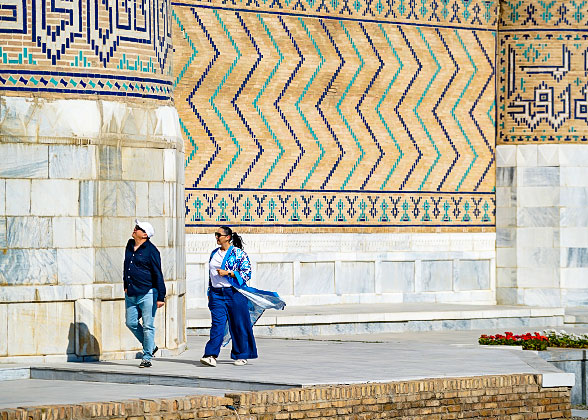
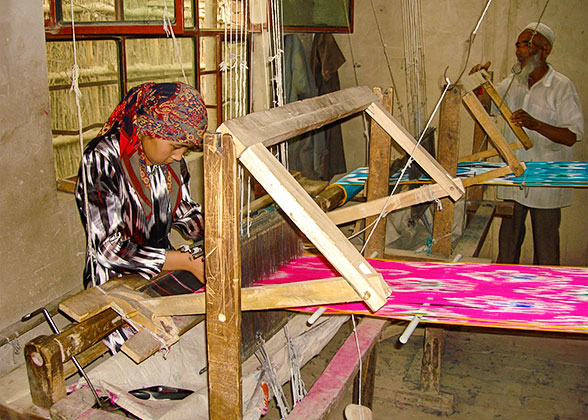
Then, leave for Margilan to visit Said Akhmad-Khoja Madrasah, a 19th-century Islamic school now a handicraft workshop, where you can see many handmade silk, pottery products, and simple machines working on silk-making. Besides, since Margilan is the silk industry center of Central Asia, you can’t miss Yodgorlik Silk Factory, the largest traditional handmade silk factory in Uzbekistan, which has preserved the conventional techniques of Altas and Ikat for thousands of years. Following the factory’s particular route for tourists, you will be guided to different workshops to learn about the entire process, from steaming cocoons to reeling, dyeing, and weaving into silk, and the final gorgeous Khanatlas, hand-woven single-sided patterned silk, is Margilan’s greatest pride.
Ultimately, we will drive about one hour to Andijan in the deep Heaven Mountains, once the wealthiest place in the Transoxiana region. In 1902, a sudden earthquake of magnitude 8.5 nearby devastated Andijan, destroying all the ancient buildings and leaving the town with no original appearance. Still, the people of Andijan did not give up their homes and rebuilt the city bit by bit with their hands. Actually, Andijan is more well-known because it’s the hometown of Babur, the founder of the Mughal Empire; therefore, we will visit Babur Memorial Park and House Museum to find more stories about him. Finish visiting, you’ll be escorted to the hotel in Andijan.
Meal: Breakfast
Accommodation: Toshkent Hotel, Andijan (4 stars) or similar

Modari Khan Mausoleum

Yodgorlik Silk Factory
Day 9 Border Crossing to Kyrgyzstan, Visit Mountain Museum in Osh, Fly to Bishkek
Today, the Uzbek driver will transfer you to Dostyk Border Crossing. After completing the border crossing formalities, your Kyrgyz guide and driver will pick you up and drive you to Osh.
► Tips at Dostyk Border Crossing
The Uzbek side is stringent about checking all your luggage and asking for medicines in detail, so if there is a long queue, it may take 1 to 2 hours to get through the border. But the Kyrgyz side is much faster by checking only passports. Since there are no toilets or stores at the border crossing, it is recommended to go to the bathroom in advance and bring food and water.
Uzbekistan is mainly plains and deserts, while Kyrgyzstan is primarily mountainous, with Heaven Mountains running through the entire country, so you will feel a significant drop in temperature. Also due to the terrain, Uzbeks live a stable farming and breeding life in the Fergana Basin and other oases, while Kyrgyz people live a nomadic life in the mountains. Therefore, in Kyrgyzstan, you will experience more of a nomadic culture and developed animal husbandry.
Your first spot in Kyrgyzstan is the Sulaiman Mountain Museum. As a beacon for former mountain travelers, Sulaiman Mountain is revered as a holy mountain, with numerous ancient religious sites and rock paintings on its five peaks and slopes. Thus, the radar-shaped museum, which combines natural and artificial caves, was built to protect these rock paintings; its architecture will surprise you as much as the exhibits. Go downhill, and we will move on to visit a local Osh bazaar.
In the afternoon, the guide will accompany you on a 45-minute flight to Bishkek, the capital of Kyrgyzstan. After landing, the local driver will take you to lunch and check in at the hotel. When traveling through the city in the car, you can see the snow-capped peaks afar of the surrounding mountains and pass by numerous cultural institutions and museums, whose squares, flower beds, sculptures and fountains form an inviting cityscape.
► Where Can You Visit in the Free Time
You can walk 20 minutes north from your hotel or take a taxi for 5 minutes to the State History Museum, whose ticket is KGS 200 (about $2.35). Its rich and exquisite collection, including ceramics, weapons, handicrafts, modern paintings, etc., and even an authentic yurt, shows Kyrgyzstan’s ancient to modern and contemporary history, which will not disappoint you.
Meals: Breakfast, Lunch, Dinner
Accommodation: Orion Hotel Bishkek (5 stars) or similar
► Tips at Dostyk Border Crossing
The Uzbek side is stringent about checking all your luggage and asking for medicines in detail, so if there is a long queue, it may take 1 to 2 hours to get through the border. But the Kyrgyz side is much faster by checking only passports. Since there are no toilets or stores at the border crossing, it is recommended to go to the bathroom in advance and bring food and water.
Uzbekistan is mainly plains and deserts, while Kyrgyzstan is primarily mountainous, with Heaven Mountains running through the entire country, so you will feel a significant drop in temperature. Also due to the terrain, Uzbeks live a stable farming and breeding life in the Fergana Basin and other oases, while Kyrgyz people live a nomadic life in the mountains. Therefore, in Kyrgyzstan, you will experience more of a nomadic culture and developed animal husbandry.
Your first spot in Kyrgyzstan is the Sulaiman Mountain Museum. As a beacon for former mountain travelers, Sulaiman Mountain is revered as a holy mountain, with numerous ancient religious sites and rock paintings on its five peaks and slopes. Thus, the radar-shaped museum, which combines natural and artificial caves, was built to protect these rock paintings; its architecture will surprise you as much as the exhibits. Go downhill, and we will move on to visit a local Osh bazaar.
In the afternoon, the guide will accompany you on a 45-minute flight to Bishkek, the capital of Kyrgyzstan. After landing, the local driver will take you to lunch and check in at the hotel. When traveling through the city in the car, you can see the snow-capped peaks afar of the surrounding mountains and pass by numerous cultural institutions and museums, whose squares, flower beds, sculptures and fountains form an inviting cityscape.
► Where Can You Visit in the Free Time
You can walk 20 minutes north from your hotel or take a taxi for 5 minutes to the State History Museum, whose ticket is KGS 200 (about $2.35). Its rich and exquisite collection, including ceramics, weapons, handicrafts, modern paintings, etc., and even an authentic yurt, shows Kyrgyzstan’s ancient to modern and contemporary history, which will not disappoint you.
Meals: Breakfast, Lunch, Dinner
Accommodation: Orion Hotel Bishkek (5 stars) or similar
Day 10 Bishkek: Visit Oak Park and Local Squares, Hike in Ala Archa National Park
Today, follow your guide to enjoy a morning walk in Bishkek’s iconic squares and parks. Pay a short visit to Old Square and move on to Oak Park through the vast and tree-lined Freedom Avenue. Meet the statue of Kurmanjan Datka, a female politician in Kyrgyzstan in the 19th century, whose image is also printed on the 50-som banknote of Kyrgyzstan, and submerge yourself in the acres of green oak trees behind the statue.
Continue to Ala-Too Square at the heart of Bishkek, where the Manas Triumphal Statue stands. Dotted with neo-brutalist architecture, the square is ideal for taking photos; get ready your cameras significantly when the soldiers change guards or raise the Kyrgyz flag. In summer, you may also encounter half of the square exhibiting attractive flowers and performing musical fountain shows.
Then, come to the final Victory Square to watch various large memorial sculptures and an eternal flame, among which the prominent Victory Monument was built in 1985 to commemorate the 40th anniversary of the end of World War II. You will be deeply moved when looking at the sculpture of a woman under the giant yurt-shaped monument as if waiting for her husband to come home.
Meals: Breakfast, Lunch, Dinner
Accommodation: Orion Hotel Bishkek (5 stars) or similar
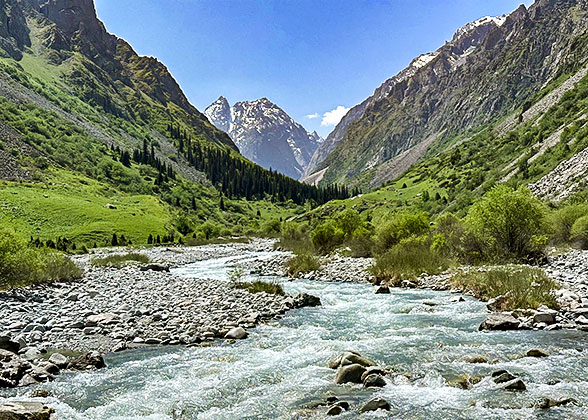
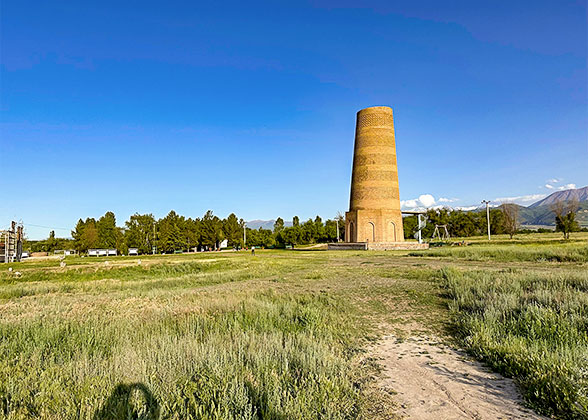
Continue to Ala-Too Square at the heart of Bishkek, where the Manas Triumphal Statue stands. Dotted with neo-brutalist architecture, the square is ideal for taking photos; get ready your cameras significantly when the soldiers change guards or raise the Kyrgyz flag. In summer, you may also encounter half of the square exhibiting attractive flowers and performing musical fountain shows.
Then, come to the final Victory Square to watch various large memorial sculptures and an eternal flame, among which the prominent Victory Monument was built in 1985 to commemorate the 40th anniversary of the end of World War II. You will be deeply moved when looking at the sculpture of a woman under the giant yurt-shaped monument as if waiting for her husband to come home.
★ Crowning Touch of Bishkek: Hike & Picnic in Ala Archa National Park
As we gradually drive away from the city and finally arrive at the park, you feel like stepping into a wonderland. Marvel at the colossal Heaven Mountains rising in the distance, with some cloud-kissing peaks nearly 5,000 meters (16,400 feet) above sea level, where snow clings to mountaintops all year round and shines brightly in the sun. After hiking in the picturesque valley filled with lush forests, devour a picnic lunch while listening to an incredible natural symphony of birds singing and the rushing Ala Archa River. Finally, the guide and driver will escort you back to the hotel.Meals: Breakfast, Lunch, Dinner
Accommodation: Orion Hotel Bishkek (5 stars) or similar

Ala Archa National Park

Burana Tower
Day 11 Bishkek – Burana Tower – Cholpon Ata (Visit Petroglyphs Museum) – Karakol
Today, we will first drive for 1.5 hours to Burana Tower, an 11th-century minaret. Here, you can also see the ruins of the Balasagun site - once a crucial trade center on the ancient Silk Road - and stone carvings left by the Turks.
Keep driving for three hours along Lake Issyk-Kul. As we gradually approach our destination, outside the window is the vast crystal blue lake; on the other side are immense wheat fields, which will remind you of how Van Gogh describes the wheat fields in the sun – boundless as the ocean, delicate yellow and delicate soft green.
Ultimately, we’ll reach Cholpon Ata, a resort town on the northern shore of Lake Issyk-Kul, to visit the Petroglyphs Museum. It looks like a large area of messy rocks from a distance, but they are painted with cattle, sheep, deer, camels and tableau vivant of hunting, which span a wide range of years from 4000 BC to 10th century AD. You can follow the museum’s marks to find splendid rock paintings, especially the most eye-catching one depicting a scene of snow leopards battling wild goats. Finally, we’ll drive another three hours to Karakol and check in at the hotel.
Meals: Breakfast, Lunch, Dinner
Accommodation: My Hotel Karakol (3 stars) or similar
Keep driving for three hours along Lake Issyk-Kul. As we gradually approach our destination, outside the window is the vast crystal blue lake; on the other side are immense wheat fields, which will remind you of how Van Gogh describes the wheat fields in the sun – boundless as the ocean, delicate yellow and delicate soft green.
Ultimately, we’ll reach Cholpon Ata, a resort town on the northern shore of Lake Issyk-Kul, to visit the Petroglyphs Museum. It looks like a large area of messy rocks from a distance, but they are painted with cattle, sheep, deer, camels and tableau vivant of hunting, which span a wide range of years from 4000 BC to 10th century AD. You can follow the museum’s marks to find splendid rock paintings, especially the most eye-catching one depicting a scene of snow leopards battling wild goats. Finally, we’ll drive another three hours to Karakol and check in at the hotel.
Meals: Breakfast, Lunch, Dinner
Accommodation: My Hotel Karakol (3 stars) or similar
Day 12 Karakol – Karkyra Border Crossing – Kazakhstan: Visit Kaindy Lake, Stay at Saty Village
If it happens to be a Sunday, the guide will accompany you to the Sunday-only Karakol Animal Market, where the locals trade cattle, horses, sheep and camels. After that, drive nearly two hours to the Karkyra Border Crossing with a stopover at San Tash village to visit a large cairn of the same name left by Timur’s army to commemorate the fallen soldiers.
Cross the border and meet your Kazakhstan driver guide. Unlike Kyrgyzstan, where mountains cover 70% of its land, Kazakhstan has a vast territory and diverse landforms, including vast grasslands, deserts, gobi, alpine forests, lakes, and unique canyons, all of which we will explore in the following trip.
After picking up, the driver guide will take you to admire the bewitching scenery of Kaindy Lake. Being an untouched spot, the journey to Kaindy Lake is thrilling, crossing puddles and rubble beaches, turning corners and climbing slopes, feeling like a literal “roller coaster.” Still, the first sight of the breathtaking lake, like a giant crystal embedded in the valley, is all worth it. Words will fail when you see the submerged spruce forest standing in the lake for over 100 years, as if time stands still here.
In the end, the driver guide will transfer you to Saty Village. Staying in a guest house of hospitable Kazakhs, you can see how local villagers live and taste Kazakh specialties cooked with local ingredients, such as Lagman - a noodles dish with meat and vegetables, pilaf - a fried rice dish, and beef and mutton dumplings, allowing you to experience authentic Kazakhstan life.
Meals: Breakfast, Lunch, Dinner
Accommodation: Saty Village guest house
Cross the border and meet your Kazakhstan driver guide. Unlike Kyrgyzstan, where mountains cover 70% of its land, Kazakhstan has a vast territory and diverse landforms, including vast grasslands, deserts, gobi, alpine forests, lakes, and unique canyons, all of which we will explore in the following trip.
After picking up, the driver guide will take you to admire the bewitching scenery of Kaindy Lake. Being an untouched spot, the journey to Kaindy Lake is thrilling, crossing puddles and rubble beaches, turning corners and climbing slopes, feeling like a literal “roller coaster.” Still, the first sight of the breathtaking lake, like a giant crystal embedded in the valley, is all worth it. Words will fail when you see the submerged spruce forest standing in the lake for over 100 years, as if time stands still here.
In the end, the driver guide will transfer you to Saty Village. Staying in a guest house of hospitable Kazakhs, you can see how local villagers live and taste Kazakh specialties cooked with local ingredients, such as Lagman - a noodles dish with meat and vegetables, pilaf - a fried rice dish, and beef and mutton dumplings, allowing you to experience authentic Kazakhstan life.
Meals: Breakfast, Lunch, Dinner
Accommodation: Saty Village guest house
Day 13 Saty Village: Hike between Lower and Middle Kolsai Lakes
Today, the driver guide will drive you to Kolsai Lakes and accompany you on a challenging hike between two lakes. Located in Heaven Mountains’ middle and high-altitude areas, the three Kolsai Lakes remain less disturbed by tourist influx with its original beauty. Under sunlight, the lakes, surrounded by alpine meadows and forests, change from light blue to a rich emerald color, worthy of being lauded as the “Pearls of Northern Heaven Mountains.”
We will hike 7 to 8 kilometers (4.5 to 5 miles) for about three hours from Lower Kolsai Lake to Middle Kolsai Lake and have a boxed lunch there. After a short break, we will return along the same route, which may take another three hours. Don’t worry if your physical strength is limited to meeting Middle Kolsai Lake on foot; you can also rent a horse to ride the same trail. Rest early tonight after returning to Saty Village to release the trekking fatigue.
* Note: Horseback riding is at your own expense with a two-way fee of $30-40 per person and is available only from April to October.
► Tips for Kolsai Lakes Hike
1. To deal with the changeable climate and significant temperature difference in the mountains, you’d better wear windproof and warm clothing and bring a light raincoat.
2. Bring chocolate, nuts, dried meat or other food to replenish your energy quickly during such a long hike.
3. Since Kolsai Lakes is close to the border with Kyrgyzstan, be sure to carry your passport if we encounter border guards checking.
Meals: Breakfast, Lunch-box, Dinner
Accommodation: Saty Village guest house
We will hike 7 to 8 kilometers (4.5 to 5 miles) for about three hours from Lower Kolsai Lake to Middle Kolsai Lake and have a boxed lunch there. After a short break, we will return along the same route, which may take another three hours. Don’t worry if your physical strength is limited to meeting Middle Kolsai Lake on foot; you can also rent a horse to ride the same trail. Rest early tonight after returning to Saty Village to release the trekking fatigue.
* Note: Horseback riding is at your own expense with a two-way fee of $30-40 per person and is available only from April to October.
► Tips for Kolsai Lakes Hike
1. To deal with the changeable climate and significant temperature difference in the mountains, you’d better wear windproof and warm clothing and bring a light raincoat.
2. Bring chocolate, nuts, dried meat or other food to replenish your energy quickly during such a long hike.
3. Since Kolsai Lakes is close to the border with Kyrgyzstan, be sure to carry your passport if we encounter border guards checking.
Meals: Breakfast, Lunch-box, Dinner
Accommodation: Saty Village guest house
Day 14 Saty Village – Charyn Canyon National Park – Chunja Hot Springs
Today, we will drive for 1.5 hours to Charyn Canyon National Park, where the Charyn River has eroded a deep canyon from 150 to 300 meters (490 to 985 feet). Carved by nature for 12 million years, its magical landscape of bizarre and colorful rock formations with jagged stones in various shapes awaits you to admire.
From the Charyn Canyon growing rare ash trees, the Temirlik Canyon with steep red cliffs, the Bestamak Canyon, a treasure trove of ancient fossils, to the Moon Canyon (Uzunbulak Canyon) with a lunar-like landscape, and the Valley of Castles with uniquely shaped boulders, we will spend a whole day fully explore Charyn Canyon and its famous branches.
► How to Capture Charyn Canyon like a Travel Photographer
1. Work with the light: When the light is soft in the morning, use trees and the river as embellishments to capture the canyon’s layered rock formations. When the sun sets, shoot the red rocks with warm orange, red and golden yellow tones to create a romantic and spectacular atmosphere.
2. Find a view: Stand on the No. 1 viewing platform of the Valley of Castles, where you can overlook the entire canyon, to photograph the panoramic view of the winding canyon against the vast sky.
3. Clothing tip: Wear bright colors like indigo that contrast strongly with the canyon’s brick, earth, red and yellow hues to enrich the images.
After visiting, the driver guide will transfer you to our well-selected hotel at Chunja Hot Springs.
Meal: Breakfast, Lunch-box, Dinner
Accommodation: Kara Dala Hot Springs Resort or similar
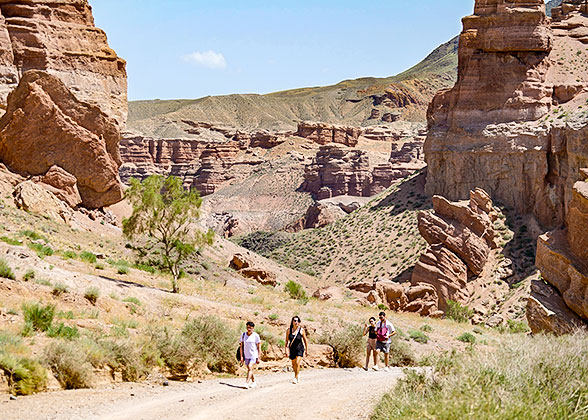
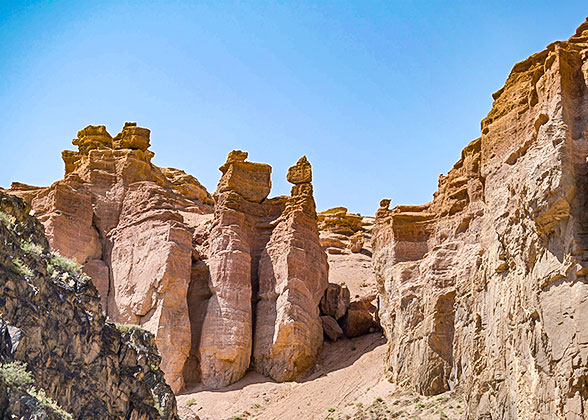
From the Charyn Canyon growing rare ash trees, the Temirlik Canyon with steep red cliffs, the Bestamak Canyon, a treasure trove of ancient fossils, to the Moon Canyon (Uzunbulak Canyon) with a lunar-like landscape, and the Valley of Castles with uniquely shaped boulders, we will spend a whole day fully explore Charyn Canyon and its famous branches.
► How to Capture Charyn Canyon like a Travel Photographer
1. Work with the light: When the light is soft in the morning, use trees and the river as embellishments to capture the canyon’s layered rock formations. When the sun sets, shoot the red rocks with warm orange, red and golden yellow tones to create a romantic and spectacular atmosphere.
2. Find a view: Stand on the No. 1 viewing platform of the Valley of Castles, where you can overlook the entire canyon, to photograph the panoramic view of the winding canyon against the vast sky.
3. Clothing tip: Wear bright colors like indigo that contrast strongly with the canyon’s brick, earth, red and yellow hues to enrich the images.
After visiting, the driver guide will transfer you to our well-selected hotel at Chunja Hot Springs.
Meal: Breakfast, Lunch-box, Dinner
Accommodation: Kara Dala Hot Springs Resort or similar

Charyn Canyon National Park

Charyn Canyon National Park
Day 15 Chunja Hot Springs – Zharkent – Basshi Village – Altyn Emel National Park
This morning, we’ll drive to Zharkent in around two hours. Upon arrival, visit the artfully designed Zharkent Mosque, with its colorful Chinese-style pavilion structure. The ingenious combination of cylindrical arcades and large eaves visually makes you feel spacious, reflecting Islamic elegance and refinement, from which you can glimpse the deep cultural integration. Then, pay a short visit to a local bazaar and drive another two hours to Basshi Village.
After hotel check-in and a lunch break, follow your driver guide to have fun in Altyn Emel National Park. With a unique semi-desert climate, the landscape here spans steppes, gobi and deserts. It also boasts different archaeological sites, where you can see the remains of ancient settlements and numerous rock paintings showing hunting scenes. Also, as part of UNESCO’s “Man and the Biosphere” program, Altyn Emel is home to 16 rare animal species; if lucky, try to find as many animals as possible.
However, the highlight of this afternoon in the national park is to climb Singing Dunes, settled due to years of strong winds. You may find it’s nothing special at first, but when the wind blows, it “sings” like an organ, whose volume changes according to the wind speed, sometimes light and lively while sometimes wild and rough. Finally, the driver guide will escort you back to the hotel in Basshi Village.
Meal: Breakfast, Lunch-box, Dinner
Accommodation: Basshi Hotel
After hotel check-in and a lunch break, follow your driver guide to have fun in Altyn Emel National Park. With a unique semi-desert climate, the landscape here spans steppes, gobi and deserts. It also boasts different archaeological sites, where you can see the remains of ancient settlements and numerous rock paintings showing hunting scenes. Also, as part of UNESCO’s “Man and the Biosphere” program, Altyn Emel is home to 16 rare animal species; if lucky, try to find as many animals as possible.
However, the highlight of this afternoon in the national park is to climb Singing Dunes, settled due to years of strong winds. You may find it’s nothing special at first, but when the wind blows, it “sings” like an organ, whose volume changes according to the wind speed, sometimes light and lively while sometimes wild and rough. Finally, the driver guide will escort you back to the hotel in Basshi Village.
Meal: Breakfast, Lunch-box, Dinner
Accommodation: Basshi Hotel
Day 16 Altyn Emel National Park: Hike around Aktau & Katutau Mountains; Drive to Almaty
Don’t worry if you didn’t enjoy it enough yesterday since we will come to Altyn Emel National Park again this morning and spend three hours hiking around two famous mountains here.
First, we’ll reach the Aktau Mountains, which date back 400 million years when they were at the bottom of an ancient ocean in the Ili River Valley. Now, their towering peaks and vibrant colors mesmerize you, serving as a unique geological wonder and open-air museum displaying prehistoric flora and fauna remains.
Next, get to the Katutau Mountains, formed by volcanic activity thousands of years ago, offering a unique landscape of ash and lava flows, bizarre and fascinating. Standing at its highest point at 1,720 meters (5,643 feet) above sea level, you’ll have a breathtaking view of the surroundings. In addition, the Katutau Mountains are home to various wildlife, including argali, goitered gazelles, and wild donkeys, allowing you to observe these attractive creatures in their natural habitat.
Finally, we will visit a 700-year-old willow in an oasis near the Katutau Mountains and drive for 3.5 hours from Altyn Emel to Almaty.
Meal: Breakfast, Lunch, Dinner
Accommodation: Renion Park Hotel, Almaty (3 stars) or similar
First, we’ll reach the Aktau Mountains, which date back 400 million years when they were at the bottom of an ancient ocean in the Ili River Valley. Now, their towering peaks and vibrant colors mesmerize you, serving as a unique geological wonder and open-air museum displaying prehistoric flora and fauna remains.
Next, get to the Katutau Mountains, formed by volcanic activity thousands of years ago, offering a unique landscape of ash and lava flows, bizarre and fascinating. Standing at its highest point at 1,720 meters (5,643 feet) above sea level, you’ll have a breathtaking view of the surroundings. In addition, the Katutau Mountains are home to various wildlife, including argali, goitered gazelles, and wild donkeys, allowing you to observe these attractive creatures in their natural habitat.
Finally, we will visit a 700-year-old willow in an oasis near the Katutau Mountains and drive for 3.5 hours from Altyn Emel to Almaty.
Meal: Breakfast, Lunch, Dinner
Accommodation: Renion Park Hotel, Almaty (3 stars) or similar
Day 17 Almaty Airport See-off
As our 17-day Uzbekistan Kyrgyzstan Kazakhstan tour packages draw to an end, it’s time to say goodbye to Almaty. Today, the driver guide will pick you up at the hotel and escort you to Almaty Airport. Wish you had a good time with us and a smooth journey home!
If you want to continue touring Almaty to visit Green Bazaar, Central Mosque, Kok-Tobe Hill and other attractions, or expand your trip to the other Central Asian countries like Turkmenistan and Tajikistan, please feel free to contact our travel consultants to customize your itinerary!
► Unmissable Landmark before Leaving Almaty
During your free time today, you can walk 5 minutes from your hotel to visit the Ascension Cathedral, a wooden Ukrainian Baroque Orthodox cathedral in Panfilov Park. From afar, you will gravitate toward its bright-colored appearance; walk inside to appreciate its gorgeous and exquisite icons and altar paintings, which align with the medieval Byzantine painting style and partially combine the Catholic style after the Renaissance. It is the best choice for appreciating Almaty’s art, culture and fantastic architecture.
Meal: Breakfast
If you want to continue touring Almaty to visit Green Bazaar, Central Mosque, Kok-Tobe Hill and other attractions, or expand your trip to the other Central Asian countries like Turkmenistan and Tajikistan, please feel free to contact our travel consultants to customize your itinerary!
► Unmissable Landmark before Leaving Almaty
During your free time today, you can walk 5 minutes from your hotel to visit the Ascension Cathedral, a wooden Ukrainian Baroque Orthodox cathedral in Panfilov Park. From afar, you will gravitate toward its bright-colored appearance; walk inside to appreciate its gorgeous and exquisite icons and altar paintings, which align with the medieval Byzantine painting style and partially combine the Catholic style after the Renaissance. It is the best choice for appreciating Almaty’s art, culture and fantastic architecture.
Meal: Breakfast
Expand All
Collapse All
This trip can be customized to meet your individual needs!
Itineraries you may also like:
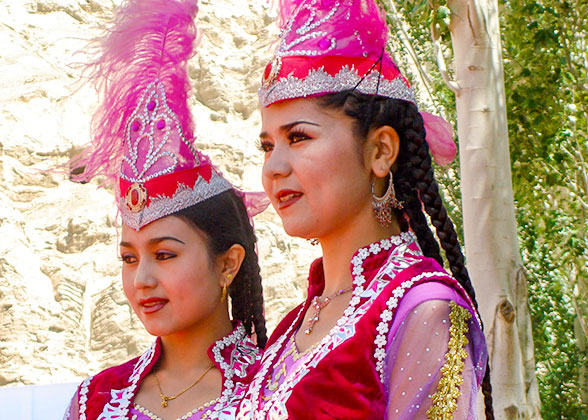 21 Days Tashkent - Urgench - Khiva - Bukhara - Samarkand - Penjikent - Seven Lakes - Penjikent - Osh - Karakol - Jeti-Oguz - Karakol - Basshi - Almaty
21 Days Tashkent - Urgench - Khiva - Bukhara - Samarkand - Penjikent - Seven Lakes - Penjikent - Osh - Karakol - Jeti-Oguz - Karakol - Basshi - Almaty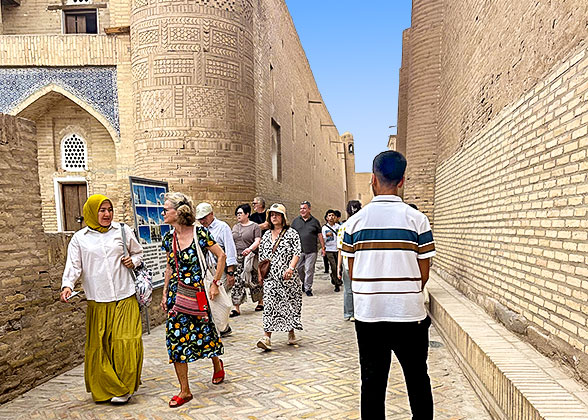 14 Days Tashkent - Khiva - Bukhara - Gijduvan - Samarkand - Tashkent - Fergana - Osh - Bishkek - Karakol - Jeti-Oguz - Bishkek
14 Days Tashkent - Khiva - Bukhara - Gijduvan - Samarkand - Tashkent - Fergana - Osh - Bishkek - Karakol - Jeti-Oguz - Bishkek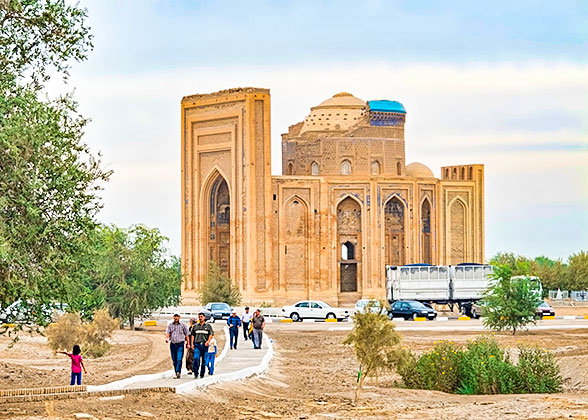 10 Days Ashgabat - Darvaza - Kunya Urgench - Khiva - Bukhara - Samarkand - Tashkent
10 Days Ashgabat - Darvaza - Kunya Urgench - Khiva - Bukhara - Samarkand - Tashkent
